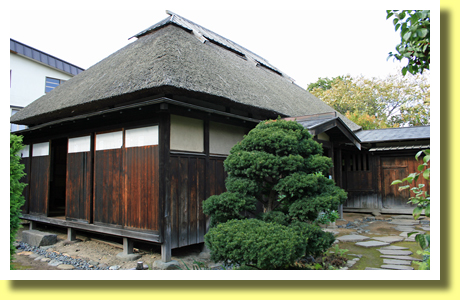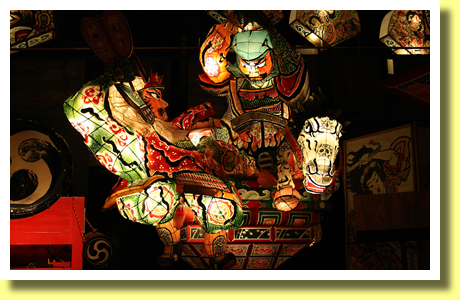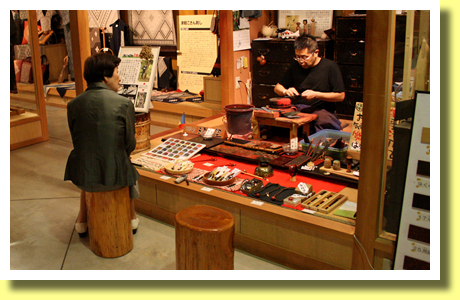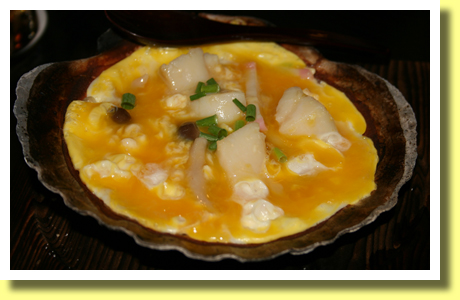|
|
|
|
|
|
|
Achi-Kochi Japan
Showing many places to visit and foods to eat in Japan
|
|
|
|
|
|
|
|
|
|
|
|
|
Japan
> Tohoku region
> Hirosaki City
|
|
|
|
|
|
|
Hirosaki City
Aomori, Tohoku ( Achi-Kochi Japan )
|
|
|
|
|
|
|
|
|
|
|
|
|
( "Achi-Kochi" in Japanese means "Here and there" in English. )
Hirosaki City, Aomori Pref., Tohoku

Hirosaki city, located in the west of Aomori Prefecture, used to be the center of Hirosaki Domain ( or Tsugaru Domain ), which was one of feudal domains through Tokugawa period ( the 17th century - 19th century ==> A History of Japan vol.2 Samurai Age ). So in the city there remain many relating to the feudal domain - old castle, buke yashiki ( residences of samurai families ), old temples.
Also there remain lots of the local and traditional - Tsugaru Nuri ( lacquerware ), Tsugaru Jamisen ( musical instrument ), Neputa Matsuri ( festival ) as well as traditional local dishes.
|
|
Hirosaki-jo Castle

Hirosaki-jo Castle was built in A.D. 1611, since then on the castle and the city had been the economic and political center of Tsugaru area and Hirosaki Domain for Tokugawa Period ( the 17th century - 19th century ). While in A.D. 1627 the 1st main keep was burnt down, the 2nd main keep ( remaining as above ) was built in A.D. 1810. Also there remain some gates, turrets, stone walls and moats. Hirosaki-jo is one of the original castles remaining in Japan.
There are a few thousands of cherry trees around the castle. So the castle is one of the best places in Japan to enjoy Hanami ( Sakura Viewing ) in the season of cherry blossoms. The Cherry Blossom Festival is held in early May.
|
|
Buke Yashiki ( Samurai Residence )

During Tokugawa Period, many feudal retainers lived around the castle. So there remain some residences of samurai ( feudal retainers ) families in Historical House Preservation Area surrounding Hirosaki-jo Castle. The above photo shows Former Iwata House which is one of Buke Yashiki ( samurai residences ). Tourists could walk into Former Iwata House which would show how samurai families lived a few hundreds years ago.
|
|
Merchant House

A feudal domain needed merchants as well as samurai. So there remain merchant houses near the castle. The above shows Ishiba House, which was built in Mid-19th century ( the end of Tokugawa Priod ). It is said that Ishiba family handled household goods and straw products in Hirosaki Domain.
|
|
Zenrin-Gai

It was thought that Hirosaki-jo Castle had a weakness in the southwest. So to strengthen the castle, by the 2nd feudal lord of Hirosaki Domain, more than 30 temples were built in and moved to an area named "Zenrin-Gai" which is located to the southwest of the castle. The area was expected to be a fort practically. The above shows the gate of Choshoji Temple which is one of the temples located in Zenrin-Gai area.
|
|
Hirosaki Neputa Matsuri

Hirosaki city is famous for Neputa Matsuri ( Neputa Festival ), held through 1st-7th August every year. In Neputa Matsuri, more tha 80 floats parade the town to traditional drums and flutes. Tourists could see festival floats ( above ) in Hirosaki Neputa Hall even not in the Neputa week in August. In the hall, traditional Neputa music is played with drums and flutes.
There is Hirosaki Neputa Hall in Tsugaru-Han Neputa Mura, which is located to the northeast of the castle. ( "Han" means a feudal domain and "Mura" means a village. )
|
|
Tsugaru-Nuri ( Lacquerware )

In Tsugaru-Han Neputa Mura, there is Tsugaru Craft Center named "Takumi", where visitors could see craftsmanship evolved over the generations in Tsugaru area. For example, in the craft center, a ctaftsman shows how Tsugaru-Nuri is made ( above ).
Tsugaru-Nuri is the traditional lacquerware inherited and developed in Hirosaki and surrounding areas. In the 17th century the 4th feudal lord of Tsugaru Domain invited many craftsmen, one of whom improved technique of lacquerware. Since then on, his successors developed Tsugaru-Nuri, of which the crafting process requires almost 50 steps.
In Tsugaru Craft Center, visitors could see various craftsmanship not only of Tsugaru-Nuri, but also of Tsugaru-Yaki ( Pottery ), Tsugaru-Nishikie ( Paintings ), Kokeshi ( Dolls ), Kogin-Sashi ( Embroidery ) and so on. All of them have been inherited in the area.
|
|
Tsugaru Jamisen

Furthermore Hirosaki city is famous for Tsugaru Jamisen, which is a traditional musical instrument with three strings. In Tsugaru-Han Neputa Mura, there is Sangen-Do where visitors could enjoy live performance ( above ) of Tsugaru Jamisen ( "Sangen" means three strings. ). Live performace is offered several times a day.
|
|
Kaiyaki-Miso

In Hirosaki city, there are many restaurants which offer traditional local dishes. The above shows Kaiyaki-Miso, which is one of mother's dishes in Tsugaru area.
A big shell ( "kai" ) of scallop is used as a pan. A beaten egg with "miso" ( soybean paste ) on a shell is grilled ( "yaki" ). Sometimes pieces of scallops, fish and vegetables are added as ingredients. Each family has their own recipe. Kaiyaki-Miso is one of local specialty dishes.
|
|
Igamenchi

The above, another Mom's seafood dish in the area, shows "Igamenchi". Igamenchi is deep fried dish of chopped squid's legs with vegetables.
In Tsugaru area they pronounce "Igamenchi", while in the other area "Ikamenchi" I guess.
In Hirosaki city and Tsugaru area, there are many more traditional local dishes. On the way from/to Shirakami-Sanchi, tourists could stay in hotels in the area. On such occasions, it is worth exploring traditional local dishes in restaurants.
|
Copyright (c) 2021 Achi-Kochi Zanmai Co., Ltd.
|